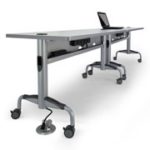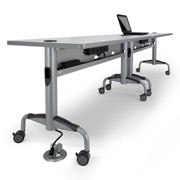
Flexibility was a key theme at the 2010 InfoComm conference in Las Vegas, North America’s largest audio-visual (AV) technology show, where a number of companies demonstrated products intended to help schools deploy education technology more easily.
With more than 60 years of experience in designing furniture that helps students learn, Bretford showcased a number of solutions aimed at simplifying the integration of technology into the classroom. These included laptop carts that can intelligently sense how much power is needed to charge the units and deliver just enough power to meet these needs, as well as a clutter-free system for delivering power to as many as eight computer workstations from a single electrical outlet.
Bretford also unveiled a first-of-its-kind lectern with a built-in, 40-inch flat-panel display on the front, designed to highlight speaker information or reinforce key lecture concepts, and it announced a contest in which it will give away more than $17,000 worth of classroom furniture to one lucky school.
Bretford’s next-generation laptop carts can store up to 20 laptops horizontally or up to 30 laptops vertically. Their 270-degree hinges allow for both front and rear doors to fold back against the carts’ sides, allowing for easy access to the machines, and their perforated metal top, sides, and doors give the laptops ventilation while recharging.
But it’s the carts’ “brain” that is their most innovative feature. The “brain” uses microchip technology to distribute power to the laptops proportionately, reducing heat and saving battery life at the same time.
At InfoComm, Bretford also demonstrated a special netbook cart that it custom-designed for the San Diego Unified School District. The cart can store and charge up to 42 netbooks, and its shelves are removable, so you can take out a shelf to insert a printer or other peripheral device if you don’t need to store so many netbooks. The 42-netbook cart was designed specifically for the San Diego school system but is available for other schools as well.
In older school buildings in particular, it can be costly to add the electrical infrastructure needed to set up computers in a classroom. Bretford’s new Juice Power System aims to solve that problem. It allows up to four tables and eight computer stations to be powered from a single outlet, without the expense of hardwiring or the clutter of individual power strips.
The Juice Power System features a “toolless” installation that doesn’t require an electrician or a building modification, Bretford says, so it can be incorporated into a facility for less than half the cost of most hardwired components. The system will be available in the second half of July at a list price that averages $150 per table.
Schools that are still using Bretford products they bought decades ago have a chance to win free Bretford furniture through a new video contest, the company also announced. Schools that send in a video showing their oldest Bretford product in use are eligible to win furniture for a 30-student classroom, including 15 tables, a Presenter’s Assistant for Learning cart, a laptop cart, a flat-panel display cart, and a projection screen. The total value of the giveaway is more than $17,000. The deadline for submissions is Aug. 31, 2010; for more information, go to www.bretford.com/contest.
Another company that aims to make classroom technology as flexible and simple to deploy as possible is Extron Electronics, which highlighted an easy-to-use AV control system for classrooms with a single display source.
Extron’s WallVault Systems are designed for classrooms with a wall-mounted short-throw projector or flat-panel display. WallVault Systems include all the necessary audio and video switching, sound amplification, system control, source connectivity, speakers, mounting hardware, and cabling for a complete classroom AV solution, the company says; all that’s left to add is the video projector or flat-panel display itself.
Teachers can control their projector or flat-panel display through a wall-mounted controller, switching back and forth between a computer, DVD, VCR, or other media source connected to the display and adjusting the volume as necessary. Or, they can control the system via the school’s network, using a graphical interface on a web page.
WallVault Systems use Cat 5 twisted pair cabling for carrying the audio and video signals between the wall plate input and switcher. Twisted pair cabling is lighter, smaller, and more flexible than coaxial cable, Extron says, so it is easier to route through walls and pull through small conduits. What’s more, all the necessary switching and amplification is housed in the projector’s wall mount itself, thereby securing these electrical components and hiding them from view.
Califone has added flexibility to its Infrared Classroom Audio sound-amplification system, giving educators a way to tap into announcements made from a school’s main office. The redesigned console now features a dedicated port that receives an audio signal directly from the school’s office, complete with local volume control—essentially turning the classroom audio system into a public address and emergency-alert system as well.
“Traditionally, the Infrared Classroom Audio System has been used by classroom teachers to ensure that all students can hear clearly what they need to hear, whether it is the teacher’s own voice or other AV-based activities,” said Tim Ridgway, vice president of marketing for Califone. “Our upgraded system now helps schools to implement and maintain a school-wide announcement and emergency-response solution cost-effectively.”
At InfoComm, Califone also introduced a new Assistive Listening System, which enables educators to give any number of designated students a personal listening device to clearly hear the teacher or other amplified audio.
In smaller areas, the system helps hearing-challenged students overcome inadequate classroom acoustics and high levels of ambient noise, thereby increasing engagement and achievement. In larger settings, such as in auditoriums or outdoor applications like field trips, it means that specific students can receive extra audio support, whether for increased amplification or tailored for a tour-group activity.
Though kit sizes vary—and are configurable for any size group—the core of the system includes a 900 MHz transmitter for the presenter that can be fitted with either a headset or mini-condensor microphone, and any number of wireless receivers (with connecting headphones) for listeners.
The receivers feature dual headphone jacks, so one can be shared with a classmate. This also makes the system helpful for those who need translation support, Califone says, such as for non-English speaking parents at back-to-school nights.
Listeners can choose between a lightweight headphone or a single ear headphone attached to the receiver. The receivers and transmitter can be worn with a lanyard around the neck or hip worn with its belt clip.
“This new listening system is ideal for tour groups and wherever it is imperative that all students can hear the teacher clearly, despite language barriers or disabilities,” Ridgway said. It’s also a cost-effective way for schools using wireless microphones on the now-banned 700 MHz frequency band to switch over to another frequency, he added.
The RoomPro ONE, from RoomPro Technologies, is a fully integrated, all-in-one classroom AV control and microphone system that enables K-12 educators to provide an enhanced audio and video experience to improve student learning. RoomPro ONE is equipped with a built-in infrared microphone system that offers optimized voice enhancement and 360-degree sound reinforcement. It also includes a wall panel for simple, one-touch control. The wall panel also can be controlled with a Virtual Control Panel, RoomPro’s proprietary control panel emulation software that allows teachers to operate the system using multiple devices.
“RoomPro ONE solves the problem of uneven classroom sound distribution and … the related problem of uneven learning experiences from student to student,” said Dean Olds, president of RoomPro Technologies. “And, with the addition of our Virtual Control Panel, we have found a way to provide educators with more convenient system control and access. Teachers can now quickly and easily operate the system at the touch of a button, whether they are working from a laptop, a wireless tablet, or an interactive whiteboard.”
The company also makes a ceiling enclosure device designed to house a classroom’s speakers, AV switches, projector mount, and audio amplifier. The enclosure comes with the mounting hardware.
Chief Manufacturing also specializes in complete AV room systems that are ideal for classroom and lecture hall use. The company’s new CoPilot system is a modular, all-in-one, networked AV solution that is fully upgradeable, meaning school leaders can start with some components and add others later, as necessary.
Incorporating every component required to bring audio and video into a classroom environment, all within a single SKU, the system includes wireless radio-frequency microphone technology, fire alarm override, high-performance plenum speakers, professional-grade cabling, and a simple interface, Chief said. The RF microphone system has a range of up to 40 feet, without the line-of-sight issues that can crop up with infrared systems in a large classroom. The CoPilot system also features 25-watt mono or stereo amplification, paging to specific rooms or school zones, and a bilingual mode.
Yet another company whose products are intended to give educators greater flexibility in how they deploy AV technology is Draper, which has sold projection screens to schools for more than 50 years.
Last year, the company introduced a product called Stage Screen, a completely modular framing system (with optional legs) for creating truss screens ranging in size from 5’ x 8’ all the way up to 30’ x 40’ for large outdoor displays. School personnel can use Stage Screen to build projection surfaces of whatever size they need, for either temporary or permanent use.
Draper President John Pidgeon said customers liked the idea of Stage Screen, but some said it was too expensive for smaller installations, such as classrooms or boardrooms. So at this year’s InfoComm, Draper unveiled a smaller, more economic modular screen framing system, called Focal Point. It works just like Stage Screen, but it’s smaller (supporting screen sizes up to 20 feet wide) and costs about half as much, Pidgeon said.
- Ozobot Launches Self-Service Professional Development Courses - April 17, 2024
- Demco Acquires StickTogether, Accelerating StickTogether’s Mission and Expanding Demco’s Range of Innovative Solutions - April 16, 2024
- EPS Learning Programs Selected by Virginia Board of Education as Recommended Literacy Solutions - April 15, 2024

